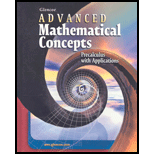
Concept explainers
(a)
To find: The mean of the salaries.
(a)
Answer to Problem 31E
The mean of the salaries is
Explanation of Solution
Given:
The given data of salaries of ten employee are as:
Calculation:
The mean is calculated as:
The mean of the salaries is
(b)
To find: The median of the salaries.
(b)
Answer to Problem 31E
The median of the salaries is
Explanation of Solution
After arranging the data in ascending order, the median is calculated as:
The median of the salaries is
(c)
To find: The mode of the salaries.
(c)
Answer to Problem 31E
The mode of the salariesis
Explanation of Solution
The mode is the most occurring number in the data, so the mode is given as:
The mode of the salaries is
(d)
To find: The measure of central tendency might an employee can use when asking for a raise.
(d)
Answer to Problem 31E
The employee can use the mean.
Explanation of Solution
The mean considered as the best measure of central tendency so an employee will use the mean. That he can use when asking for a raise.
Therefore an employee can use the mean.
(e)
To find: The measure of central tendency might management use to argue against a raise for an employee.
(e)
Answer to Problem 31E
The measure of central tendency might management use is mode.
Explanation of Solution
Since the mode is the least measure of central tendency so the management can use mode to argue against a raise for an employee.
The measure of central tendency might management use is mode.
(f)
To find: The measure of central tendency that is most representative of the data.
(f)
Answer to Problem 31E
The median is the most representative of the data.
Explanation of Solution
Since the Mean is affected by the extreme values of
So the median is the most representative of the data.
(g)
To write: The convincing argument that you deserve a raise in salary when making salary
(g)
Answer to Problem 31E
The reason is given below.
Explanation of Solution
Here is a convincing argument that you deserve a raise:
I have been with the company for many years, and I am still making less than the mean salary.
The explanation is given above.
Chapter 14 Solutions
Advanced Mathematical Concepts: Precalculus with Applications, Student Edition
Additional Math Textbook Solutions
Calculus: Early Transcendentals (2nd Edition)
University Calculus: Early Transcendentals (4th Edition)
Single Variable Calculus: Early Transcendentals (2nd Edition) - Standalone book
University Calculus: Early Transcendentals (3rd Edition)
Calculus: Early Transcendentals (3rd Edition)
 Calculus: Early TranscendentalsCalculusISBN:9781285741550Author:James StewartPublisher:Cengage Learning
Calculus: Early TranscendentalsCalculusISBN:9781285741550Author:James StewartPublisher:Cengage Learning Thomas' Calculus (14th Edition)CalculusISBN:9780134438986Author:Joel R. Hass, Christopher E. Heil, Maurice D. WeirPublisher:PEARSON
Thomas' Calculus (14th Edition)CalculusISBN:9780134438986Author:Joel R. Hass, Christopher E. Heil, Maurice D. WeirPublisher:PEARSON Calculus: Early Transcendentals (3rd Edition)CalculusISBN:9780134763644Author:William L. Briggs, Lyle Cochran, Bernard Gillett, Eric SchulzPublisher:PEARSON
Calculus: Early Transcendentals (3rd Edition)CalculusISBN:9780134763644Author:William L. Briggs, Lyle Cochran, Bernard Gillett, Eric SchulzPublisher:PEARSON Calculus: Early TranscendentalsCalculusISBN:9781319050740Author:Jon Rogawski, Colin Adams, Robert FranzosaPublisher:W. H. Freeman
Calculus: Early TranscendentalsCalculusISBN:9781319050740Author:Jon Rogawski, Colin Adams, Robert FranzosaPublisher:W. H. Freeman
 Calculus: Early Transcendental FunctionsCalculusISBN:9781337552516Author:Ron Larson, Bruce H. EdwardsPublisher:Cengage Learning
Calculus: Early Transcendental FunctionsCalculusISBN:9781337552516Author:Ron Larson, Bruce H. EdwardsPublisher:Cengage Learning





